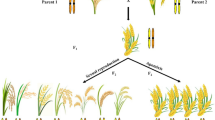Summary
The endosperm has played a significant role in the evolution of angiosperms because of its physiological and genetic relationships to the embryo. One manifestation of this evolutionary role is its abnormal development in interploidy crosses. It is now established that the endosperm develops abnormally in interploidy-intraspecific crosses when the maternal: paternal genome ratio deviates from 2∶1 in the endosperm itself. We propose an Endosperm Balance Number (EBN) hypothesis to explain endosperm development in both interploidy-intraspecific and interspecific crosses. Each species is assigned an EBN on the basis of its crossing behavior to a standard species. It is the EBN which determines the effective ploidy in the endosperm of each species, and it is the EBNs which must be in a 2∶1, maternal:paternal ratio. The EBN of a species may be determined by a few genes rather than the whole genome. This hypothesis brings most intraspecific-interploidy and interspecific crossing data under a single concept with respect to endosperm function. The implications of this hypothesis to isolating mechanisms, 2n gametes, the evolution of disomic polyploids, and reciprocal differences in seed development are discussed.
Similar content being viewed by others
Literature
Avery, A.G.; Satina, S.; Rietsema, J. (1959): Blakeslee: The Genus Datura. New York: Ronald Press
Beck, C.B. (1976): Origin and early evolution of angiosperms. New York: Columbia University Press
Brink, R.A.; Cooper, D.C. (1947): The endosperm in seed development. Bot. Rev. 13, 423–541
Clausen, R.E.; Cameron, D.R. (1950): Inheritance in Nicotiana Tabacum: XXIII. Duplicate factors for chlorophyll production. Genetics 35, 4–10
Cooper, D.C.; Brink, R.A. (1945): Seed collapse following matings between diploid and tetraploid races of Lycopersicon pimpinellifolium. Genetics 30, 376–401
Cooper, D.C. (1951): Caryopsis development following matings between diploid and tetraploid strains of Zea mays. Am. J. Bot. 38, 702–708
Darlington, C.D. (1976): The great events in chromosome evolution. In: Current chromosome research. Amsterdam: Elsevier
Garcia-Olmedo, F.; Carbonero, P.; Arancillo, C.; Salcedo, G. (1978): Loss of redundant gene expression after polyploidization in plants. Experientia 34, 332–333
Gill, B.S.; Waines, J.G. (1978): Paternal regulation of seed development in wheat hybrids. Theor. Appl. Genet. 51, 265–270
Grant, V. (1971): Plant speciation. New York: Columbia University Press
Hanneman, R.E., Jr.; Peloquin, S.J. (1967): Crossability of 24-chromosome potato hybrids with 48-chromosome cultivars. Eur. Potato J. 10, 62–73
Hanneman, R.E., Jr.; Peloquin, S.J. (1968): Ploidy levels of progeny from diploid-tetraploid crosses in potato. Am. Potato J. 45, 255–261
Irikura, Y. (1968): Studies on interspecific crosses of tuber-bearing Solanums. 1. Overcoming cross-incompatibility between Solanum tuberosum and other Solanum species by means of induced polyploids and haploids. Res. Bull. Hokkaido National Agr. Expt. Station
Johnston, S.A.; Hanneman, R.E., Jr. (1978): Endosperm balance factors in some tuberbearing Solarium species. Am. Potato J. 55, 380 (Abstr.)
Johnston, S.A.; Hanneman, R.E., Jr. (in press): Support of the endosperm balance number hypothesis utilizing some tuberbearing Solanum species. Am. Potato J.
Lesins, K. (1961): Interspecific crosses involving alfalfa. 1. Medicago dzhawakhetica (Bordz.) Vass X M. sativa L. and its peculiarities. Can. J. Genet. Cytol. 3, 135–152
Lin, B.V. (1975): Parental effects on gene expression in maize endosperm development. Madison, Wis.: Dissertation University of Wisconsin
Marks, G.E. (1966): The origin and significance of intraspecific polyploidy: experimental evidence from Solanum chacoense. Evolution 20, 552–557
Mendiburu, A.O.; Peloquin, S.J. (1976): Sexual polyploidization and depolyploidization: some terminology and definitions. Theor. Appl. Genet. 48, 137–143
Müntzing, A. (1930): Über Chromosomenvermehrung in Galeopsis — Kreuzungen und ihre phylogenetische Bedeutung. Hereditas 14, 153–172
den Nijs, Ton P.M.; Peloquin, S.J. (1977)a: 2n gametes in potato species and their function in sexual polyploidization. Euphytica 26, 585–600
den Nijs, Ton P.M.; Peloquin, S.J. (1977)b: Polyploid evolution via 2n gametes. Am. Potato J. 54, 377–386
den Nijs, Ton P.M.; Peloquin, S.J. (1977)c: The role of the endosperm in hybridization. Am. Potato J. 54, 488–489 (Abstr.)
Nishiyama, I.; Inomata, N. (1966): Embryological studies on cross incompatibility between 2x and 4x in Brassica. Jap. J. Genet. 41, 27–42
Nishiyama, I.; Yabuno, T. (1978): Causal relationships between the polar nuclei in double fertilization and interspecific crossincompatibility in Avena. Cytologia 43, 453–466
Shevtsov, I.A. (1972): Hybridization of diploid and tetraploid forms of certain species of Solanum. (translated from Russian) Genetika 8, 10–45
Stebbins, G.L. (1974): Flowering plants: evolution above the species level. Cambridge, Mass.: Belknap Press
Stebbins, G.L. (1976): Seeds, seedlings, and the origin of angiosperms. In: Origin and early evolution of angiosperms. New York: Columbia University Press
Stephens, S.C. (1942): Colchicine-produced polyploids in Gossypium. 1. An autotetraploid asiatic cotton and certain of its hybrids with wild diploid species. J. Genet. 44, 272–295
Swaminathan, M.S. (1954): Nature of polyploidy in some 48-chromosome species of the genus Solanum section Tuberarium. Genetics 39, 59–76
Tsuchiya, T. (1960): Studies on cross compatibility of diploid, triploid and tetraploid barleys. 2. Results of crosses between triploids, diploids and induced autotetraploids. Jap. J. Genet. 35, 337–343
Valentine, D.H. (1954): Seed incompatibility. Proc. 8th International Bot. Congr. Section 9, 170
Valentine, D.H. (1956): Studies in British Primula. 5. The inheritance of seed incompatibility. New Phytol. 55, 305–318
von Wangenheim, K.H. (1955): Zur Ursache der Kreuzungsschwierigkeiten zwischen Solanum tuberosum L. und S. acaule Bitt. bzw. S. stoloniferum Schlechtd. et Bouché. Z. Pflanzenzücht. 34, 748
von Wangenheim, K.H. (1957): Untersuchungen über den Zusammenhang zwischen Chromosomenzahl und Kreuzbarkeit bei Solanum — Arten. Z. ind. Abst. Vererbungsl. 88, 21–37
von Wangenheim, K.H.; Peloquin, S.J.; Hougas, R.W. (1960): Embryological investigations on the formation of haploids in the potato (Solanum tuberosum). Z. Vererbungsl. 91, 391–399
Watkins, A.E. (1932): Hybrid sterility and incompatibility. J. Genet. 25, 125–162
Wellensiek, S.J. (1955): The genetics of diploid X tetraploid and reciprocal cyclamen crosses. Züchter 25, 229–230
Woodell, S.R.J.; Valentine, D.H. (1961): Studies in British Primula. 9. Seed incompatibilities in diploid-autotetraploid crosses. New Phytol. 60, 282–294
Author information
Authors and Affiliations
Additional information
Communicated by H.F. Linskens
Rights and permissions
About this article
Cite this article
Johnston, S.A., den Nijs, T.P.M., Peloquin, S.J. et al. The significance of genic balance to endosperm development in interspecific crosses. Theoret. Appl. Genetics 57, 5–9 (1980). https://doi.org/10.1007/BF00276002
Received:
Issue Date:
DOI: https://doi.org/10.1007/BF00276002




